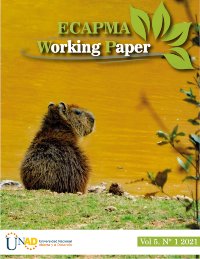Published
How to Cite
Production of bovine embryos from the invitro Colombia laboratory during 2019
In vitro fertilization emerged 40 years ago; it is one of the reproductive biotechnologies that are currently being applied in the country, producing embryos commercially on a large scale in cattle, which increases the use of the genetic potential of the female.
Knowledge gap: Colombia does not constantly present production data since commercial laboratories do not publish their results, avoiding a positioning of the country in the world map of reproductive biotechnology applied to commercial production.
Purpose: The intention of this study is to make an approach to the average production of a laboratory dedicated to the production of bovine in vitro embryos (IVEP) in Colombia.
Methodology: The embryo production of INVITRO COLOMBIA SAS laboratory was evaluated for the year 2019, in terms of IVEP, taking into account techniques such as follicular aspiration (OPU), which can be performed by the presence of follicular waves of the bovine estrous cycle which allow the collection of oocytes throughout their productive life, in vitro maturation (IVM), in vitro fertilization (IVF) and in vitro culture (IVC), 8 days after follicular aspiration the embryos produced are delivered. Variables corresponding to production and racial and zootechnical preference in the applicability of the technique by the producer were evaluated. Descriptive statistics were used for the analysis by obtaining averages.
Results and conclusions: The production of oocytes per donor is 24 per session, the average embryo production was 4. The obtaining of viable oocytes corresponds to 83.7%, the division of zygotes was 66.5% and the production of embryos from viable oocytes was 19.3%. Regarding the zootechnical vocation of the animals submitted to the technique, 76.4% corresponded to dairy cattle and 23.6% to beef cattle. The breed in which the technique is most used is the Gyr breed, especially for crossbreeding with European breeds for the production of F1 adapted for dairy cattle in the tropics, as well as the Guzerat and Brahman.
Similar Articles
- Diana Cristina Medina Valencia, Erika Tatiana Obando Anaya, Mountain microorganisms, an alternative for the biofertilization of agricultural crops , Working Papers ECAPMA: Vol. 6 (2022)
- Andres Felipe Leon Betancur, Bovina colombiana animal welfare in the colombian bovine meat chain , Working Papers ECAPMA: Vol. 7 (2023)
- Claudia Parra Cortés, Alexandra Ceron Endo, Guillermo Caicedo Diaz, Jhon Jairo Cuellar Veru, Evaluation of the incidence of Phytophthora spp. in cocoa clones, with applications of Trichoderma spp. in the municipality of Algeciras, Huila , Working Papers ECAPMA: Vol. 8 (2024)
- Myriam Janeth Ortega Torres, José Camilo Torres Romero, Julialba Ángel Osorio, Aproximación al estudio genómico de la característica capacidad de retención de agua, en carne de ovejas de pelo colombianas , Working Papers ECAPMA: Vol. 1 No. 1 (2017)
- Ángela María Luna Villegas, Andrea Viviana Yate Segura, Diana Marcela Fúquene Yate, Huella hídrica: una reflexión para la adopción de prácticas corporativas sustentables , Working Papers ECAPMA: Vol. 1 No. 1 (2017)
- Diana Marcela Fuquene Yate, Andrea Viviana Yate Segura, Alternativas de aprovechamiento para los excrementos de las granjas avícolas ubicadas en el Municipio de Fómeque Cundinamarca , Working Papers ECAPMA: Vol. 1 No. 2 (2017)
- Dayro Enrique Cortes Martínez, Oscar Javier Olarte Blandon, Meliponario SIPASS - una experiencia con la abeja angelita Tetragonisca angustula con dos tipos de colmenas racionales en el de CEAD Acacias , Working Papers ECAPMA: Vol. 3 No. 2 (2019)
- Denisse Viviana Cortes Castillo, Blanca Catalina Albarracín, Maria Angélica Cardozo, MYTHS AND TRUTHS OF THE ENVIRONMENTAL DIMENSION , Working Papers ECAPMA: Vol. 4 No. 1 (2020)
- Fanny Matilde Pinzon Candelario, Environmental interpretation as a strategy in enviromental education with schoolchildren of primary basic studies at the Agape reserve of the municipality of Leticia (Amazonas) , Working Papers ECAPMA: Vol. 5 No. 1 (2021)
- Blanca Mercedes Gómez Guerrero, Janer Eugenio Payares Guerrero, Alexander Salazar Montoya, Flora Manuela Ariza Molina, Agronomic characteristics of the pepper (Capsicum annuum L.) of 3 varieties in the municipality of Valledupar -Cesar , Working Papers ECAPMA: Vol. 5 No. 1 (2021)
You may also start an advanced similarity search for this article.
Most read articles by the same author(s)
- Danilo Bonilla Trujillo, Viviana Vanadia Villamil Reyes, John Fredy Montes Mora, Uso de simuladores 3D como estrategia tecnopedagógica para la transferencia de conocimiento en el aprendizaje de la anatomía animal , Working Papers ECAPMA: Vol. 3 No. 1 (2019)




